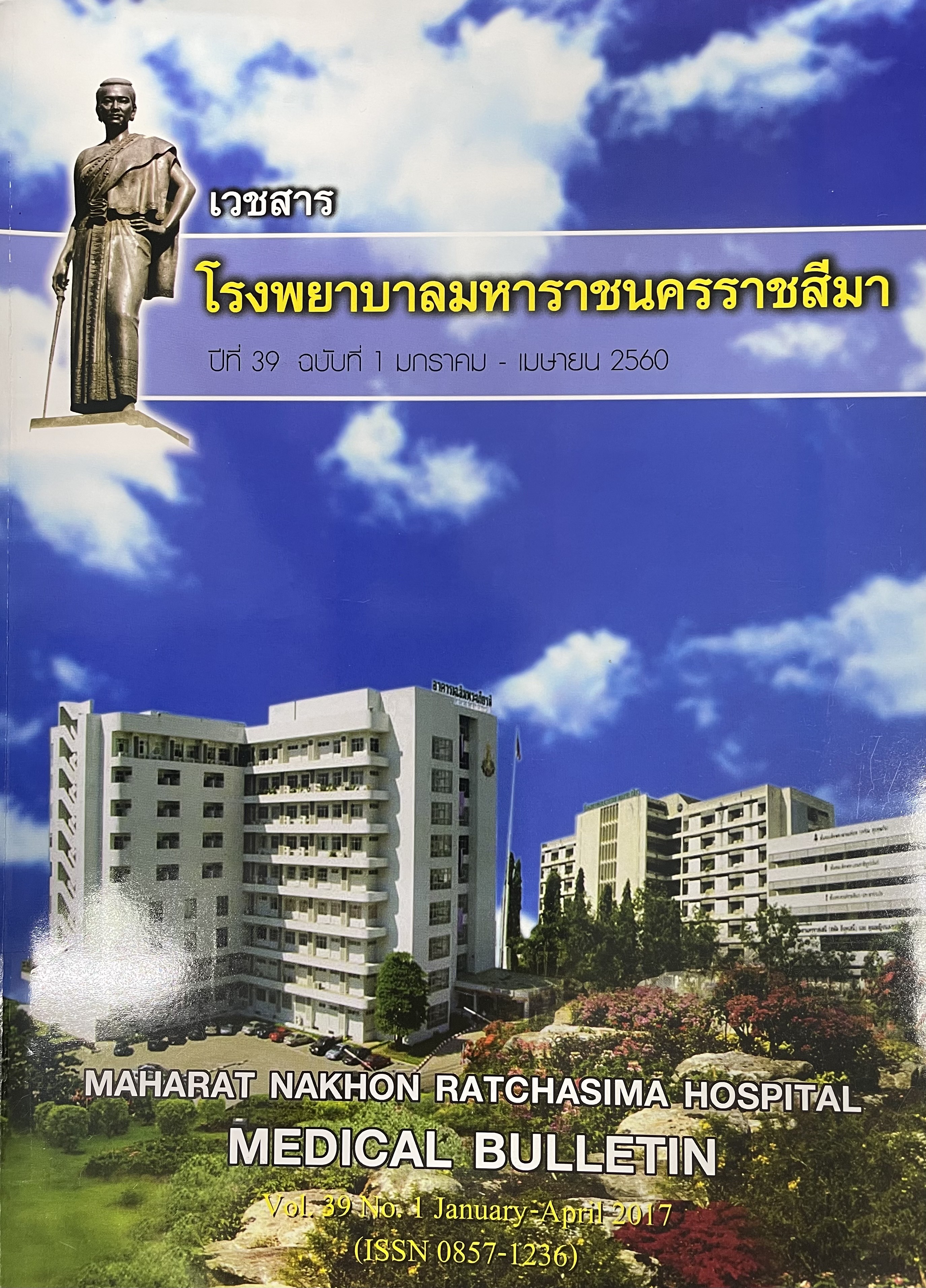ร้อยละของฮีโมโกลบินเอ2 ในผู้ที่มีฮีโมโกลบินอี
Main Article Content
บทคัดย่อ
วัตถุประสงค์: หาร้อยละของฮีโมโกลบินเอ2ในผู้ที่มีฮีโมโกลบินอีแฝงและผู้ที่มีโรค ฮีโมโกลบินอีและ เปรียบเทียบกับฮีโมโกลบินเอ2 ของกลุ่มคนปกติ ผู้ป่วยและวิธีการ: เป็นการศึกษาย้อนหลังที่กลุ่มงานอายุรกรรม โรงพยาบาลมหาราชนครราชสีมา โดยรวบรวมจากรายงานคนปกติที่มาตรวจร่างกายเป็นประจำตรวจ CBC และ ตรวจแยกชนิดของฮีโมโกลบินโดยวิธีของ Sebia capillary zone electrophoresis โดยแบ่งคนออกเป็น 3 กลุ่มได้แก่ กลุ่มคนปกติคนที่มีฮีโมโกลบินอีแฝงและกลุ่มคนที่มีโรคฮีโมโกลบินอีถ้ากลุ่มที่มีฮีโมโกลบินอีแฝง มีความเข้มข้นของฮีโมโกลบิน <12 กรัม% สำหรับเพศหญิงและ <13 กรัม% สำหรับเพศชายกับกลุ่มที่มีโรค ฮีโมโกลบิน อี ที่มีความเข้มข้นฮีโมโกลบิน <10 กรัม% จะถูกตัดออกค่าร้อยละของฮีโมโกลบินเอ2 ในกลุ่มผู้ที่มีโรคฮีโมโกลบิน อี, ฮีโมโกลบินอีแฝงและกลุ่มคนปกติจะได้รับการเปรียบเทียบ และวิเคราะห์ด้วยวิธีของ ANOVA และ un-paired student-T tests และค่า p ที่น้อยกว่า 0.05 จะถือว่ามีนัยสำคัญทางสถิติ ผลการศึกษา: จากผู้ที่มีโรคฮีโมโกลบิน อี 30 ราย, ฮีโมโกลบินอีแฝง 30 ราย และคนปกติ 30 รายพบว่าความเข้มข้นของฮีโมโกลบินเอ2 เฉลี่ยของกลุ่มที่มีโรคฮีโมโกลบินอีคือร้อยละ 5.72+0.59 ซึ่งมากกว่าร้อยละ 4.07+0.43 ของกลุ่มที่เป็นฮีโมโกลบินอีแฝง (p<0.001) และร้อยละ 2.63+0.27 ของกลุ่มคนปกติอย่างมีนัยสำคัญทางสถิติ โดยวิธี ANOVA และค่าเฉลี่ยความเข้มข้นของฮีโมโกลบินเอ2 ในผู้ที่มีฮีโมโกลบินอีแฝงก็มากกว่าของกลุ่มคนปกติโดยการตรวจด้วยวิธี un-paired student-T test อย่างมีนัยสำคัญทางสถิติเช่นกัน (p<0.001) สรุป: ค่าเฉลี่ยของความเข้มข้นฮีโมโกลบินเอ2 ในกลุ่มผู้ที่มีโรคฮีโมโกลบินอีมากกว่าของกลุ่มที่มีฮีโมโกลบินอีแฝงและของกลุ่มที่มีฮีโมโกลบินอีแฝงมากกว่าของกลุ่มคนปกติอย่างมีนัยสำคัญทางสถิติ
Article Details

อนุญาตภายใต้เงื่อนไข Creative Commons Attribution-NonCommercial-NoDerivatives 4.0 International License.
เอกสารอ้างอิง
Craver RD, Abermanis JG, Warrier RP, Ode DL, Hempe JM. Hemoglobin A levels in healthy persons, sickle cell disease, sickle cell trait, and beta-thalassemia by capillary isoelectric focusing. Am J ClinPathol 1997; 107: 88-91.
Keren DF, Hedstrom D, Gulbranson R, Ou CN, Bak R. Comparison of SebiaCapillarys capillary electrophoresis with the Primus high-pressure liquid chromatography in the evaluation of hemoglobinopathies. Am J Clin Pathol 2008;130: 824-31.
วิชัย เทียนถาวร, จินตนาพัฒ นพงศ์ธร, สมยศ เจริญศักดิ์, รัตน์ติกา แซ่ตั้ง, พิมพ์ลักษณ์ เจริญขวัญ, ต่อพงศ์ สงวนเสริมศรี. Prevalence of thalassemia carriers in Thailand. วารสารโลหิตและเวชศาสตร์บริการโลหิต 2549; 16: 307-12.
Pung-amritt P, Tanphaichitr VS, Tachavanich K, Suwantol L, Glomglao W. Prevalence of HB E from cord blood samples and after one year follow-up. Southeast Asian J Trop Med Public Health 1999; 30 Suppl 2: 97-9.
Tritipsombut J, Sanchaisuriya K, Phollarp P, Bouakhasith D, Sanchaisuriya P, et al. Micromapping of thalassemia and hemoglobinopathies in diferent regions of northeast hailand and Vientiane, Laos People’s Democratic Republic. Hemoglobin 2012; 36: 47-56.
Tachavanich K, Viprakasit V, Chinchang W, Glomglao W, Pung-Amritt P, Tanphaichitr VS. Clinical and hematological phenotype of homozygous hemoglobin E: Revisit of a benign condition with hidden reproductive risk. Southeast Asian J Trop Med Public Health 2009; 40: 306-16.
Mais DD, Gulbranson RD, Keren DF. The range of hemoglobin A(2) in hemoglobin E heterozygotes as determined by capillary electrophoresis. Am J ClinPathol 2009; 132: 34-8.
Alperin JB, Dow PA, Petteway MB. Hemoglobin A2 levels in health and various hematologic disorders. Am J ClinPathol 1977; 67: 219-26.
Keramati MR, Maybodi NT. The effect of Iron Deficiency Anemia (IDA) on the Hb A2 level and comparison of hematologic values between IDA and thalassemia minor. Int J Hematol Oncol 2007; 17: 151-6.
Sae-ung N, Srivorakun H, Fucharoen G, Yamsri S, Sanchaisuriya K, Fucharoen S. Phenotypic expression of hemoglobins A2, E and F in various Hb E related disorders. Blood Cells Mol Dis 2012; 48: 11-6.
Shokrani M, Terrell F, Turner EA, Aguinaga MD. Chromatographic measurements of hemoglobin A2 in blood samples that contain sickle hemoglobin. Ann Clin Lab Sci 2000; 30: 191-4.
Ashley-Koch A, Yang Q, Olney RS. Sickle hemoglobin (Hb S) allele and sickle cell disease: A HuGE review. Am J Epidemiol 2000; 151: 839-45.
Sharma A, Marwah S, Buxi G, Yadav R. Hemoglobin E syndromes: Emerging diagnostic challenge in North India. Indian J Hematol Blood Transfus 2013; 29: 21-5.
Vichinsky E. Hemoglobin E syndromes. Hematology Am SocHematolEduc Program 2007; 2007: 79-83


